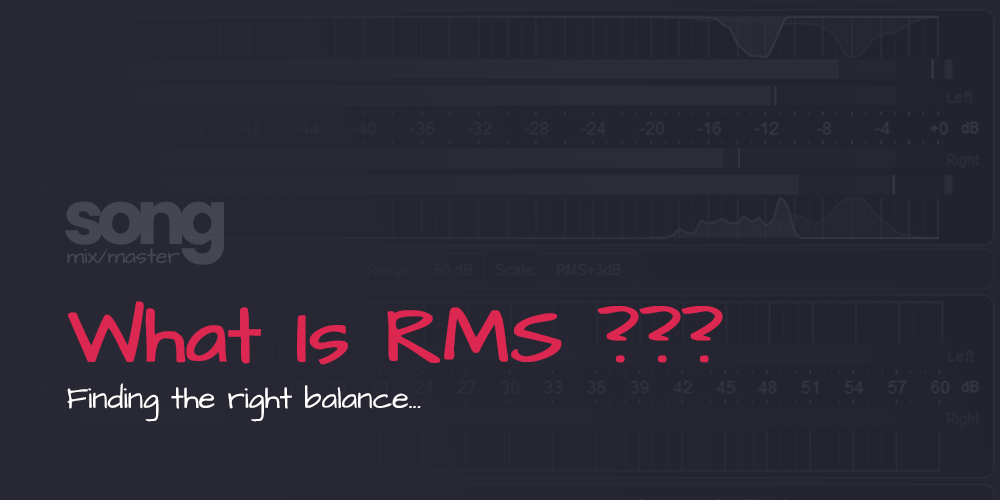Mastering
What is RMS in Music Mastering – Understanding RMS Levels
The RMS (Root Mean Square) level of a mix isn’t set in stone; it varies depending on the musical genre, production style, and the ultimate goal of the audio mastering process. However, there are general guidelines to ensure your mix maintains an appropriate RMS level.
Now, let’s delve deeper into what RMS means in sound. It’s a valuable measure because it tells us how “loud” a sound is. Imagine you set the volume control on your home audio player to a certain position and fix it in place with glue. You play a current song and notice how loud it sounds.
Then, you play songs from the ’90s, ’80s, ’70s, and so on, and you’ll observe that as you go back in decades, the volume at which you hear the music, even with the volume control fixed, decreases.
This happens because older masters had lower RMS levels; they were not as “compressed” as modern ones. If you open your sequencer and look at the waveform of any track (the time-amplitude representation of sound), you’ll see that the waveform has moments with high levels, medium levels, and others with almost no sound.
RMS is simply an average of all those levels, assigned a value. In general, it’s recommended that a mix’s RMS level falls between -12dB RMS and -6dB RMS. This means that the highest peak of the audio signal shouldn’t exceed -6dB RMS, with most of the signal hovering around -12dB RMS.
It’s essential to note that these values are just guidelines and shouldn’t be considered strict rules. Some musical genres, like hip-hop or electronic music, may have higher -3 RMS levels, while others, like classical or jazz, might have lower -14 RMS levels.
Moreover, the RMS level of a mix can also depend on the ultimate mastering goal. If the mix is to be mastered in a professional studio, the mastering engineer can adjust the RMS level to achieve the best final result. Regardless, it’s crucial for the mix to strike a balance among different elements while avoiding peaks and distortion.
Also read: Mastering Basics: Essential EQ and Compression Tips
Now, imagine you’ve finished a mix (your track is now in a stereo track), and you’re about to master it. If you open that file in a program where you can see the waveform (like Wavelab, Peak Bias, etc.), you might notice that the waveform has a lot of dynamics, meaning the peaks extend too high.
One of the things you need to do in mastering is to reduce the difference in levels between those peaks and the rest of the signal (remember that peaks occupy only a small percentage of the time).
Also read: Audio Clipping in Music: Causes, Consequences, and Solutions
When you compress first and then use a limiter in mastering, you’re essentially raising the RMS level by lowering the peaks so that they sound louder. Unfortunately, nowadays, people love high RMS levels without considering that music needs a certain dynamic range to sound like… well, music.
In summary, the RMS level of a mix can vary, but as a general guideline, it’s recommended to be between -12dB RMS and -6dB RMS.
Understanding RMS helps us grasp the average power of our audio signals and how it influences the perceived loudness of music.
However, the world of audio mastering continues to evolve, and with it, new standards and tools have emerged. This brings us to another crucial aspect of mastering: LUFS (Loudness Units relative to Full Scale).


Disclaimer: Any references to any brands on this website/webpage, including reference to products, trademarks, brands and companies, are provided for description purposes only. We don't have any association with or endorsement by these brands or companies. Some of the links on our blog may be affiliate links. This means if you click on these links and make a purchase, we may earn a commission at no extra cost to you.
Check Out My New Fabfilter Pro-Q3 Presets Pack!
You may also like to read...
7 Best Value Studio Microphones For Recording Vocals
How To Use Xfer OTT Compressor: Pro Tips Inside!
5 Best Limiter VST Plugins for Mixing and Mastering
What Are LUFS? Why Are LUFS Important In Mastering?
5 Best Budget Audio Interfaces For Home Recording Studios
5 Tips for Using The Reverb Effect in Music Production
Book My Mixing & Mastering Services